Report Back: Bark Hike To The Hipo Timber Sale
The October Bark Field trip was to the Hipo timber sale, one of four sales sold as part of the Hilynx Timber Sale
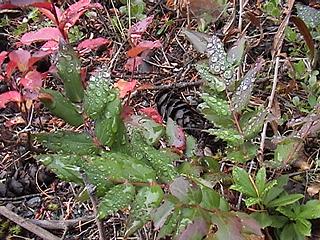
Oregon grape after a rain
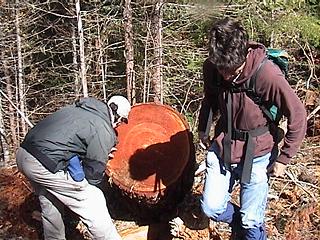
counting growth rings
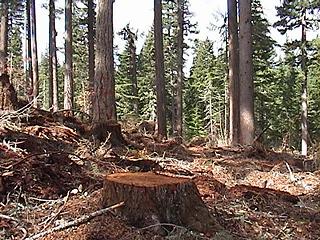
View of stumps and partial cut in background
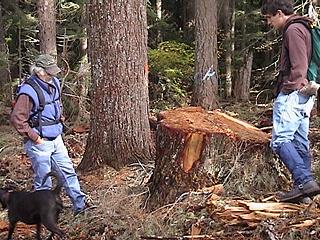
contemplating the loss of a large hemlock
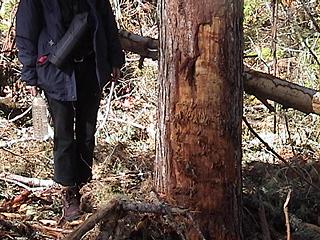
scaring from logging operation
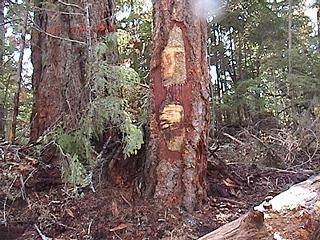
more scaring due to logging operations.
These Hipo sales contained an extreme amount
of such damage, beyond that allowed
by logging regulations.
These Hipo sales contained an extreme amount
of such damage, beyond that allowed
by logging regulations.
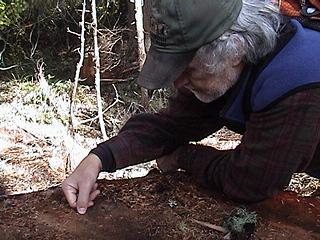
counting rings, on a stump about 4 1/2 feet in diameter
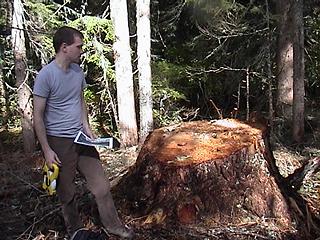
Hemlock stump, later measured at 4 1/2 feet in diameter
Included in this report is a 16 minute audio edited from that hike.
Hipo Hike, RealMedia
Hipo Hike, MP3
The Hike Leader was Joseph, who introduced the hike and gave some background of the Hipo sale itself.. This particular part of the sale was the "money unit," the sale which would bring in enough cash to make the sale worth biding on by timber companies. Many old growth Western Hemlocks and Douglas Firs were cut down, the growth rings on one tree, about 3 feet in diameter, being counted out to be around 280 years. Other trees, Western Hemlock, were measured to be in excess of 4 1/2 feet in diameter.
Joseph encourage the hikers to be aware of stumps which may have orange dots at the base, which designates a "leave" which had been unlawfully cut down. "We have found in Hipo 1A and 2 of them cutting the leave trees or scaring leave trees or uprooting the leave trees." If trees with the orange paint at the base are found, hikers were instructed to report it to someone from Bark so that they could be documented and reported to the Forest Service.
Apparently, the Forest Service do not often perform this type of monitoring. "When we went out to Hipo Unit 1A, we found way over 50, it could even go up to 75 or possibly a 100, because there were so many tree that were in that unit that were scared. It was way out of the quota that was recommended by the Environmental Assessment; but there was the uprooted and cut leave trees that the Forest Service didn't notice until we came out here and pointed them out to them."
At that point, Alex Brown, Executive Director of Bark, explained to the hikers that these forests are public lands, "that are owned by you and me. Anyone who is a taxpayer in this country is paying taxes to manage this forest....realize that this is not out of our control. This is exactly waht Bark is here to do. We''re here to monitor and make sure that our money is being spent well, that our back yard is being taken care of. This is only one of about 55 different timber sales on the Mt. Hood National Forest right now, that Bark is tracking, that we have volunteers groundtruthing to do exactly what we're doing today."
Following this was a brief discussion about the need for this type of logging in our National Forests. "....The bottom line is that private timber lands are plenty of timber to provide for the U.S. domestic housing market." Timber companies are given huge subsidies by the government, making the logging of our National Forests more profitable than the logging of their own lands. I've also learned on other Bark hikes that some of the enormous profits which are harvested from these operations find there way into the campaign coffers of many of our Federal legislators. This encourages them to view our public lands as a crop, rather than a national heritage needing protection.
On top of all this the Federal logging program has been losing money for decades. "The last time the Forest Service was audited, the Mt. Hood National Forest was found to have lost 13 million dollars....but since then they've thrown up their hands and decided that this program is too difficult to audit. We don't know how much money the government is losing."
After hiking around the Hipo sale, everyone drove to another area and prepared to search for mushrooms. During this part of the hike, Charlie gave a little talk about the interdependency of forest critters and mushrooms, and how logging upsets the natural balance. He pointed out a dead snag, perforated by pileated woodpeckers, and now the home for squirrels. "The flying squirrels live in there, and go around the forest floor collecting up the truffles, the mushrooms from the microryzel fungi, and since they have no nutritional value, they have to eat a lot of them. So they're going around eating tons of these fungi and spreading the spores around the forest. When they come through here and knock out the big trees or they knock out the forest, or they drive their tractors over the ground and knock out the mycorrhizal fungi, you're taking out one of the key components that make these large forests work."
"Interactions are well beyond anyone's ability to manage for. We have nowhere enough information about it."
This audio file was a brief synopsis of what transpired on the October Bark Field Trip. For a more complete record of Bark Hikes, please check out the Bark for Mt. Hood Public Access program, which airs from Multnomah Community Television.
This series has been running monthly since April of 1998.
More about Hilynx...




